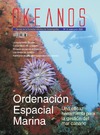Please use this identifier to cite or link to this item:
https://accedacris.ulpgc.es/handle/10553/74007
| DC Field | Value | Language |
|---|---|---|
| dc.contributor.author | Verdún Quevedo, Javier | en_US |
| dc.contributor.author | Furundarena Hernández, Asier | en_US |
| dc.contributor.author | Rendal Freire, Sara | en_US |
| dc.date.accessioned | 2020-08-06T11:39:33Z | - |
| dc.date.available | 2020-08-06T11:39:33Z | - |
| dc.date.issued | 2020 | en_US |
| dc.identifier.issn | 2444-4758 | en_US |
| dc.identifier.uri | https://accedacris.ulpgc.es/handle/10553/74007 | - |
| dc.description.abstract | ¿Recuerda el lector aquellas manchas que rodeaban el Archipiélago Canario en el verano de 2017? Aquellas mal llamadas microalgas eran, en realidad, una cianobacteria denominada Trichodesmium, que ya había protagonizado otros episodios en las islas en agosto de 2004 y octubre de 2011. Esta cianobacteria –es decir, una bacteria con la capacidad de realizar la fotosíntesis-, lejos de ideas preconcebidas, es especial por diversos motivos que se explican a lo largo de este artículo. | en_US |
| dc.language | spa | en_US |
| dc.relation.ispartof | Okeanos | en_US |
| dc.source | Okeanos [ISSN 2444-4758], n. 10, (enero-junio 2020), p. 92-95 | en_US |
| dc.subject | 2401 Biología animal (zoología) | en_US |
| dc.subject | 240119 Zoología marina | en_US |
| dc.subject.other | Trichodesmium | en_US |
| dc.subject.other | Cianobacterias | en_US |
| dc.subject.other | Islas Canarias | en_US |
| dc.title | La asombrosa vida de "Trichodesmium" | en_US |
| dc.type | info:eu-repo/semantics/article | en_US |
| dc.type | Article | en_US |
| dc.description.lastpage | 95 | en_US |
| dc.description.firstpage | 92 | en_US |
| dc.investigacion | Ciencias | en_US |
| dc.type2 | Artículo | en_US |
| dc.description.numberofpages | 4 | en_US |
| dc.utils.revision | Sí | en_US |
| dc.date.coverdate | enero 2020 | en_US |
| dc.identifier.ulpgc | Sí | es |
| item.fulltext | Con texto completo | - |
| item.grantfulltext | open | - |
| Appears in Collections: | Artículos | |
Items in accedaCRIS are protected by copyright, with all rights reserved, unless otherwise indicated.
